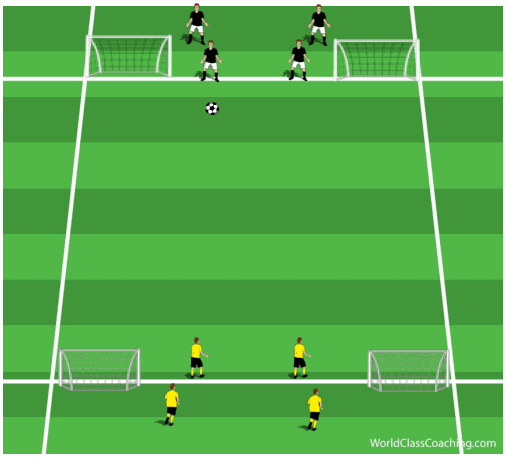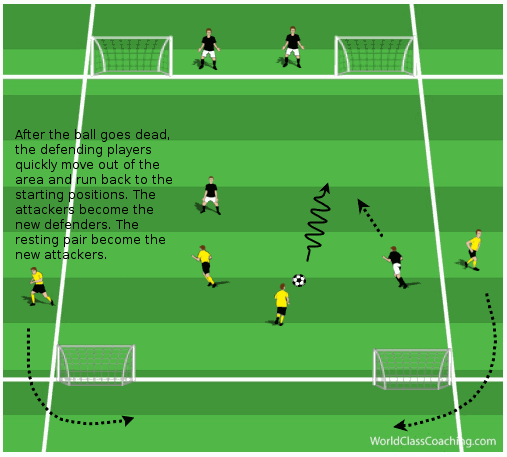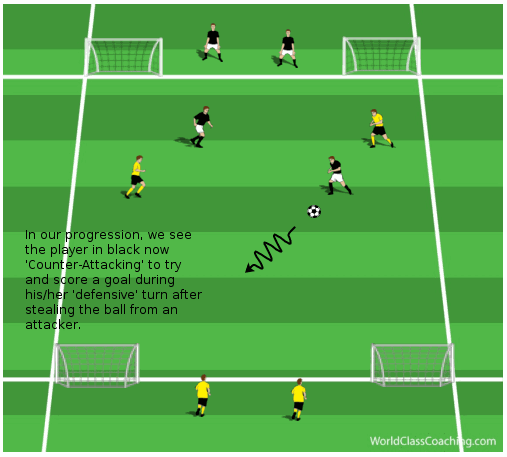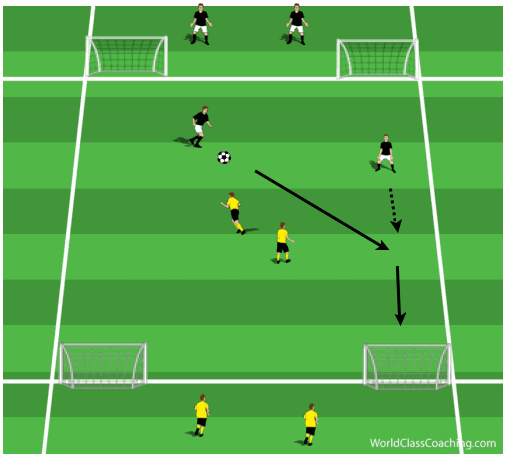By Daniel Severn
This week’s exercise is designed to help build better aerobic and anaerobic endurance. It involves short sprints, quick changes of direction, recovery defending and also helps to develop a better focus and awareness. The exercise is played at a very high tempo with the players rotating each time the ball goes dead (goal, turnover in possession, ball out of bounds).
Set Up and Directions
For this exercise you will need 4 goals, a set of soccer balls and a minimum of 8 players divided into 2 teams. Mark out a 20x20 meter area. Set up is shown below (Fig 1).

Ensure each team has a good supply of soccer balls; this will help to keep the rotation fast and intensity high. One point is scored for each goal; with the winning team being offered a reward (providing motivation is very important for good intensity and work rate during practice). For this particular exercise, I will often carry the score over to the scrimmage – providing players with a chance to start the scrimmage with a lead.
Play begins when one of the attacking players dribbles the ball onto the field, the defenders may enter the field as soon as the attacker does so. The attackers must try to score in either goal on the opposite side of the field to which they start. The defenders must try to stop them from scoring by winning the ball from them.
Below we see the attacking player making a pass to his open team mate and a shot on goal (Fig 2.)
The play is over when:
- The attacking team scores
- The ball goes out of bounds
- The defending team steals the ball
As soon as the ball goes dead, the players that were defending move off the field as quickly as possible, the attacking players become the new defending players and the players resting on the original defenders side of the field, become the new attackers – as shown below (Fig 3).

This rotation is continuous. I often put a time limit on the game in order to keep the intensity and work rate. I recommend 3 minute games with 1 minute rest.
A key factor of this exercise is the transition from attack to defense. The players must be alert to this switch from the instant their attack ends. Encourage the pair waiting to attack, that they should start very fast in order to try and catch the defenders out.
Progression – Counter Attacking
Now, when the pair that starts as the defenders steals the ball, instead of the play being over, they now have a chance to counter-attack and score themselves. This allows for a more game-like, continuous play, as opposed to short, fast attacks.

The transition remains the same, with the attacking team becoming the defenders, the defenders rest and a new pair will come in to attack. Just remember who started the play, as now either team can score!
Two or Four goals?
I use four goals for this exercise as this requires the players to develop their awareness. With two goals to defend and two to attack, you have much more to think about whatever your role on the field.
As defenders, if you do not understand your surroundings (i.e. exactly where the goal is that you’re defending, where the player is that is running off the ball) then you may make the attackers’ job easier. As attackers, it is important to have a good awareness of your surroundings in order to give yourself the best chance to shoot and to take advantage of any poor defensive positioning.
Using two goals is just as fast paced and still very exciting.
Enjoy.
Dan Severn, Program and Events Manager - BRASA Brazilian Soccer Academy



